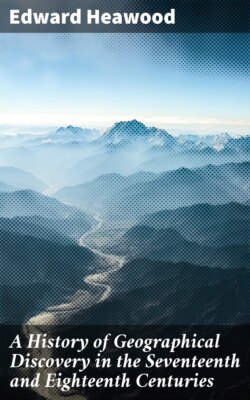A History of Geographical Discovery in the Seventeenth and Eighteenth Centuries

Реклама. ООО «ЛитРес», ИНН: 7719571260.
Оглавление
Edward Heawood. A History of Geographical Discovery in the Seventeenth and Eighteenth Centuries
A History of Geographical Discovery in the Seventeenth and Eighteenth Centuries
Table of Contents
PREFACE
INTRODUCTION
CHAPTER I
THE ARCTIC REGIONS, 1550-1625
CHAPTER II
THE EAST INDIES, 1600-1700
CHAPTER III
AUSTRALIA AND THE PACIFIC, 1605-42
CHAPTER IV
NORTH AMERICA, 1600-1700
CHAPTER V
NORTHERN AND CENTRAL ASIA, 1600-1750
CHAPTER VI
AFRICA, 1600-1700
CHAPTER VII
SOUTH AMERICA, 1600-1700
CHAPTER VIII
THE SOUTH SEAS, 1650-1750
CHAPTER IX
THE PACIFIC OCEAN, 1764-1780
CHAPTER X
RUSSIAN DISCOVERIES IN THE NORTH-EAST, 1700-1800
CHAPTER XI
THE NORTHERN PACIFIC, 1780-1800
CHAPTER XII
THE SOUTHERN PACIFIC, 1786-1800
CHAPTER XIII
THE FRENCH AND BRITISH IN NORTH AMERICA, 1700-1800
CHAPTER XIV
SPANISH AND PORTUGUESE AMERICA, 1700-1800
CHAPTER XV
ASIA, AFRICA, AND ARCTIC, 1700-1800
CONCLUSION
APPENDIX
SUPPLEMENTARY NOTES
INDEX
Отрывок из книги
Edward Heawood
Published by Good Press, 2022
.....
The voyages of the Cabots, which led the way to the north-eastern coasts of America, were not, as we have seen, followed up for a number of years by any further efforts on the part of the British merchants. The chief credit of re-directing public attention to this route seems to belong to Sir Humphrey Gilbert, though there is little doubt that the idea of renewing the search where it had been broken off by Sebastian Cabot had been working in the minds of others, among them Martin Frobisher, to whom fell the actual task of carrying it out. In 1574 Gilbert wrote a learned discourse to show the probability that an easy route to India would be found by the north-west. While based to a large extent on mistaken premisses, it contained some shrewd ideas, and the argument for a north-west passage based on a study of oceanic circulation had in it something more than mere plausibility. In the then existing state of knowledge it was certainly more justifiable to conclude that an easy passage might be found on this than on the opposite side of the Atlantic; and that the Muscovy Company, which had all Cabot's experience at its disposal, should have so long persisted in its preference for the north-east route would be matter for surprise, were it not for the encouragement offered by the rapid development of trade with northern Russia. Gilbert's treatise was not printed till 1576, by which year Frobisher had already gained so much support, that he was able to sail from Ratcliffe on the Thames on June 7, the expedition consisting of the Gabriel, Frobisher's own ship, the Michael (Captain Matthew Kindersly), and a pinnace. The Queen had taken much interest in the preparations, and among the supporters were Michael Lok, a prominent merchant, Richard Willes,[1] and others. Having reached Foula, the westernmost of the Shetland Islands, Frobisher sailed slightly north of west, and on July 11 sighted land, which was taken to be the Frisland of the Zeno map, the observed latitude of 61° corresponding to that assigned in this to the south end of Frisland. In reality it was the southern point of Greenland, and when this had been passed, a course somewhat north of west brought the ships to a new land, with much ice along its coast. On August 11, in 63° N., Frobisher entered what he took to be the desired strait leading to the Pacific, but which was really the bay, since known by his name, running into the south-eastern extremity of Baffin Land. This was explored during several days, and communication was opened with the Eskimo of that region, who are described as "like to Tartars." But it was found impossible to proceed to the end of the bay, and on the 26th the homeward voyage was begun, Harwich being reached early in October. The new land received, from the Queen herself, the name "Meta Incognita", or the Unknown Bourne.
[1 Willes, like Gilbert, wrote a treatise to prove the probability of a north-west passage, in which he endeavoured to answer the objections of those who took the opposite view. He states these with great clearness, but his own arguments seem hardly calculated to carry conviction.]
.....